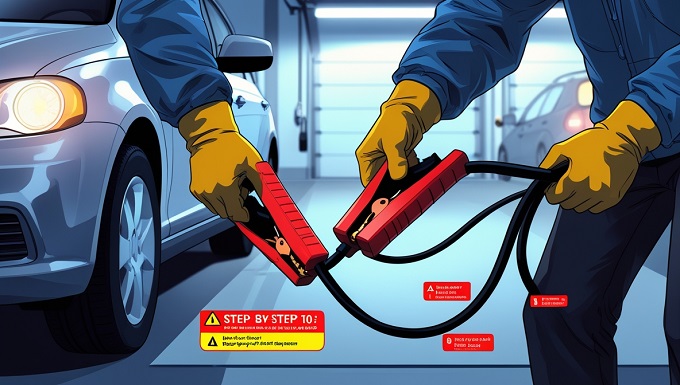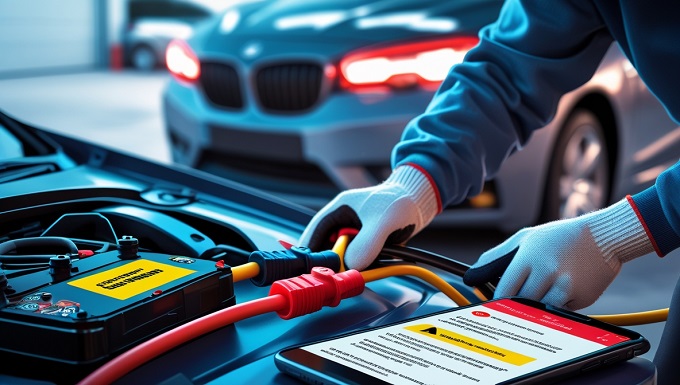There are few situations more frustrating for a driver than turning the key or pressing the start button on a car only to hear nothing but silence or a faint click. This is a telltale sign of a dead battery, one of the most common car troubles that can happen to anyone, anywhere, and at any time. While a dead battery can instantly disrupt your plans, knowing how to jumpstart a car can turn a potentially stressful roadside problem into a manageable inconvenience. It is a skill every driver should master, because it can save you valuable time, keep you safe in unfamiliar locations, and eliminate the need to wait for roadside assistance when the fix can be done in minutes with the right method.
In this comprehensive 2025 guide, we will explain not just the step-by-step process, but also the science behind car batteries, why they fail, the equipment you need, safety measures to follow, and preventive steps to avoid frequent jumpstarts. By the end, you will have an expert-level understanding that meets both beginner and advanced needs, making this your go-to resource for jumpstarting knowledge.

Understanding Car Batteries – The Power Source of Your Vehicle
A car battery is not just a box under the hood; it is the heart of your vehicle electrical system. Most vehicles use a 12-volt lead-acid battery made up of lead plates submerged in an electrolyte solution of sulfuric acid and water. This battery stores electrical energy that is released in a quick burst to start your engine, powering the starter motor and ignition system. Once your engine is running, the alternator takes over, producing electricity to power the car’s electronics and recharge the battery. Without a functioning battery, the car cannot start, no matter how healthy the engine or fuel system may be. A typical battery lasts three to five years, but lifespan can vary greatly depending on climate, driving habits, and maintenance. Understanding this basic function is essential because when your car fails to start, knowing the battery’s role can help you diagnose whether it needs a jumpstart or a replacement.
Common Reasons a Car Battery Dies
While every battery eventually wears out, there are specific conditions and mistakes that can cause it to drain prematurely. One of the most common reasons is leaving electrical accessories on when the engine is off, such as headlights, cabin lights, or the radio. Another culprit is parasitic drains, which are small but constant draws of power from onboard electronics like alarms, clocks, or malfunctioning modules even when the car is off. Weather extremes also play a significant role: in cold weather, the chemical reactions inside the battery slow down, making it harder to produce enough current to start the engine, while hot weather accelerates fluid evaporation and internal corrosion. Mechanical issues such as a failing alternator, loose or corroded battery terminals, or damaged wiring can also prevent the battery from recharging properly. And of course, natural aging eventually reduces the battery’s capacity to hold a charge, making jumpstarts more frequent until replacement is the only solution.
Safety Precautions Before Jumpstarting
Jumpstarting is a simple process, but it involves handling live electrical connections, so safety must come first. Always start by inspecting the battery for cracks, leaks, or excessive corrosion—never attempt to jumpstart a damaged battery as it may explode. Wear protective gloves and safety glasses to shield yourself from sparks or battery acid. Ensure that both vehicles are turned off, the keys are removed from the ignition, and parking brakes are engaged before connecting cables. Keep open flames, cigarettes, and sparks far away from the battery area because batteries emit flammable hydrogen gas. If your vehicle is a hybrid or electric car, consult the manufacturer’s guidelines before attempting a jumpstart, as improper procedures can damage high-voltage components or create safety hazards.
Equipment You Need for Jumpstarting
The most common method of jumpstarting involves jumper cables and a second vehicle with a fully charged battery. High-quality cables should be heavy-gauge (4 or 6-gauge recommended) with thick insulation and solid clamps that grip the battery terminals securely. The length should be sufficient to connect the two vehicles without strain—typically around 12 to 20 feet. An alternative to using another vehicle is a portable jump starter, a rechargeable power pack that can deliver the necessary current without a donor car. These devices are especially useful for emergencies in remote locations or when no one else is available to assist. Some modern models even include built-in air compressors, USB ports, and LED lights, making them multifunctional roadside tools.
Step-by-Step Guide to Jumpstarting a Car
While the process is straightforward, the order in which you connect and disconnect the cables is critical for safety and effectiveness. The following table provides a quick reference for the proper sequence:
Table 1: Correct Jumper Cable Connection Order
| 1 | Connect red cable clamp to dead battery | Positive (+) terminal |
| 2 | Connect other end of red cable to donor battery | Positive (+) terminal |
| 3 | Connect black cable clamp to donor battery | Negative (-) terminal |
| 4 | Connect other end of black cable to grounded metal surface on dead car | Unpainted engine block or chassis |
| 5 | Start donor vehicle and let it run | — |
| 6 | Start dead vehicle | — |
| 7 | Remove black clamp from grounded surface | — |
| 8 | Remove black clamp from donor battery | — |
| 9 | Remove red clamp from donor battery | — |
| 10 | Remove red clamp from revived battery | — |

Detailed Process Explanation
Begin by parking the donor vehicle close enough to the dead car so the cables can reach, but make sure the vehicles are not touching. Turn off both engines and all accessories. Attach one red clamp to the positive terminal of the dead battery, then attach the other red clamp to the positive terminal of the good battery. Attach one black clamp to the negative terminal of the good battery, and attach the other black clamp to a clean, unpainted metal surface on the dead car’s engine block or chassis—never directly to the negative terminal of the dead battery, as this can cause sparks near hydrogen gas. Once connected, start the donor vehicle and let it run for several minutes to charge the dead battery. Then attempt to start the dead vehicle. If it starts, leave both cars connected for a few more minutes before carefully disconnecting the cables in reverse order.
After the Jumpstart – What to Do Next
Once the dead vehicle is running, it’s important to allow the alternator to recharge the battery. This can be done by driving for at least 20 to 30 minutes or idling the engine, though driving is more effective as it maintains higher alternator output. Avoid turning off the engine too soon after a jumpstart, as the battery may not have enough charge to restart the car. If the battery repeatedly dies after being jumpstarted, the problem may be a failing alternator or an aging battery that needs replacement.
Troubleshooting Common Jumpstart Problem
Sometimes, a car will still refuse to start after a jump. This could be due to a severely discharged or damaged battery, poor cable connections, a faulty starter motor, or other mechanical issues. If the car starts but dies shortly afterward, it’s often a sign of alternator failure. The following table outlines common symptoms and their possible causes:
Table 2: Battery Problem Symptoms and Causes
| No sound or lights when turning key | Completely dead battery or poor cable connection |
| Click sound but no start | Weak battery or starter issue |
| Starts then dies | Alternator not charging |
| Frequent need for jumpstarts | Aging battery, parasitic drain, or charging system fault |
Maintaining Your Battery to Avoid Jumpstarts
Prevention is always better than cure. Regularly check your battery terminals for corrosion and clean them if needed using a baking soda and water solution. Ensure the battery is securely mounted to prevent vibration damage. Test the battery voltage periodically with a multimeter—healthy batteries should read around 12.6 volts when the car is off. If you drive infrequently, consider a trickle charger to maintain battery charge. During extreme weather, try to park in a garage or shaded area to protect the battery from temperature extremes.
Common Myths About Jumpstarting
Many drivers believe you can connect jumper cables in any order, but doing so increases the risk of short circuits and sparks. Another misconception is that idling the engine for a few minutes fully charges the battery; in reality, it takes much longer to reach full capacity. Some also think that jumpstarting can fix a bad battery permanently—this is false, as a failing battery will only continue to cause problems until it’s replaced.
Conclusion: Mastering the Art of Jumpstarting a Car for Safety, Convenience, and Confidence
Knowing how to jumpstart a car is more than just a handy skill – it’s a driving essential that can save you time, money, and stress in unexpected roadside situations. Whether your car battery dies in the middle of a busy morning or in a remote location, being prepared with the right knowledge, tools, and safety precautions ensures you stay in control. By understanding the exact step-by-step process, the reasons behind a dead battery, and the best maintenance practices, you not only revive your vehicle quickly but also protect yourself and your passengers from potential hazards.
The ability to jumpstart a car correctly gives you peace of mind, prevents unnecessary breakdowns, and even helps you assist others in need. But remember – while jumpstarting is a quick solution, it’s equally important to address the root cause of battery failure through proper diagnosis and timely replacements. Keep your jumper cables, safety gear, and emergency kit in your car at all times, and follow the manufacturer’s instructions to avoid costly mistakes.
In the end, being proactive about car battery care and mastering the jumpstart process makes you a more confident, self-reliant driver. It transforms an inconvenient breakdown into a manageable situation and keeps your journey moving without disruption. So the next time your engine refuses to start, you won’t panic – you’ll act with precision, safety, and confidence, turning a potential problem into proof of your preparedness.
FAQs About Jumpstarting a Car
Can jumpstarting damage my car’s electronics?
If done correctly, jumpstarting is safe, but reversing the connections or causing a voltage spike can harm sensitive electronics.
How long should I run my car after jumpstarting?
At least 20 to 30 minutes of driving is recommended to recharge the battery.
Can I jumpstart in the rain?
Yes, as long as you follow proper safety precautions and avoid standing in deep water.
Can I jumpstart an electric vehicle?
Most EVs cannot be jump-started in the traditional way. Consult your manual for specific instructions.


